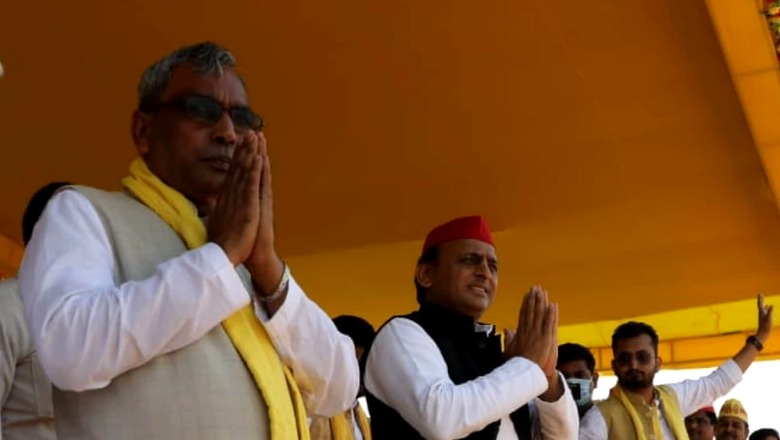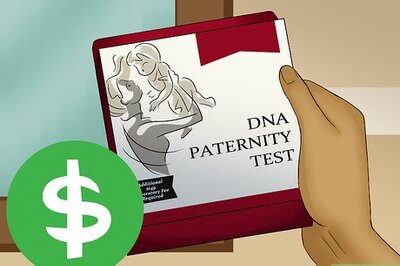
views
At the recent Bharatiya Janata Party national executive meeting, Prime Minister Narendra Modi took a jibe at the Congress by stating that his party is not “run by a family but by a culture of public welfare”.
Paradoxically, days earlier, the BJP finalised its alliance for the 2022 Assembly polls in Uttar Pradesh with seven smaller parties, previously part of a front named Hissedari Morcha.
The pact, a routine strategic move in the build-up to any poll, especially after principal BJP rival, Samajwadi Party, firmed up an alliance with Suheldev Bharatiya Samaj Party (SBSP) which brought in its wake some other smaller outfits, was, however, ironical.
This was because the parties that lined up with the BJP are, besides having caste appeal among different numerically lesser social groups, also nascent individual-centric parties with little semblance of democratic functioning. Each of these is led by individuals who either branched out from other small parties or have recently set up shop.
Past experience demonstrates that all parties—this was the case with the SP too when Mulayam Singh Yadav broke up with the parent Janata Dal almost four decades ago—start as extremely small outfits with either one or a handful of core leaders. But once they acquired popularity and political clout, family members of the principal leader joined the bandwagon and on most occasions elbowed out those who rose by the dint of their work to gradually become principal decision-makers.
The BJP’s oldest partners, who remained politically wedded to it but are now out of sync with it, the Shiv Sena and Akali Dal, have been largely but family-run parties. Prior to their disagreements in recent years, the BJP had very cosy ties with the two and never raked up their being family enterprises. This demonstrates compulsions political parties in India face and even the BJP failed to often practise what it preached.
Parties have also often been lauded for key political transitions that were illusory. For instance, in 2014, when the BJP performed phenomenally in UP winning 71 seats, leaving just a handful for dynastic candidates, it was said that with this poll, the saffron party had rendered caste ineffective.
Some scholars, quick to look at dramatic one-time developments as permanent trends, argued that India’s most populous state had entered into the post-caste phase of politics. At that point, two facts were ignored. One, that the 2014 election was the first time that either the BJP or Modi personally tom-tommed his OBC status, done obviously with an eye on milking his caste identity.
Two, it was overlooked that the BJP had forged a strategic pact in Uttar Pradesh with the Apna Dal, the Kurmi-based party set up by one-time Kanshi Ram lieutenant, Sone Lal Patel, after being sidelined within the party. Yet, the Modi-made-caste-irrelevant theory found several takers.
Although this was disproven in subsequent polls in the state, in 2017 for the Vidhan Sabha and in 2019 for the Lok Sabha especially, when the BJP not just looked at caste-based allies, but also selected candidates with an eye on their social identity; this has been doubly established this time.
Not just the BJP, but even the SP has chosen to steer clear of big parties with a broader caste base, and decided to go with smaller parties that are essentially caste-centric with support restricted to a few districts.
Like the BJP, the SP too has chosen to hitch its bandwagon with these smaller parties even though it may have been on the other side of the fence and having past disagreements. For instance, the SBSP formed last year the Bhagidari Sankalp Morcha along with several other smaller parties and was actively wooing the firebrand AIMIM leader Asaduddin Owaisi for a pact with an eye of forging a social alliance comprising the Muslims and non-Yadav OBCs to counter the SP’s traditional M-Y (Muslim-Yadav) base. Indeed, there are no permanent friends or foes in politics.
The moot question is why did Om Prakash Rajbhar, who in 2017 even held a joint rally with Amit Shah in Mau in the run-up to the 2017 polls and after election as legislator became a minister in the Yogi Adityanath government, make a complete political turnaround?
Was this due to the realisation that Muslims were continuing to look at Akhilesh Yadav as the primary challenger to the BJP? Did this have anything to do with Akhilesh Yadav’s recent controversial statement when he spoke of Mahatma Gandhi, Jawaharlal Nehru, Sardar Patel and Mohammed Ali Jinnah in one breath? Even though such a statement may enable the BJP to consolidate its core Hindutva constituency, does such seemingly banter knock off Mayawati and/or the Congress from the Muslim sweepstakes and force leaders like Rajbhar to align with SP?
Even though the polls in UP are several months away, the line-up is becoming clear. Akhilesh Yadav announced a pre-poll alliance with the SBSP, significantly at a mahapanchayat rally to mark the smaller party’s 19th foundation day and thereby heralding the addition of at least seven smaller parties to the already existing platform comprising the SP and Rashtriya Lok Dal. The parties once part of the Bhagidari Sankalp Morcha will comprise the SP-led alliance and these parties are: Mahan Dal, Janwadi Party, Bhagidari Party, Bharatiya Vanchit Party, Janata Kranti Party, Rashtriya Uday Party and Apna Dal.
In a countervailing move, the BJP has also sealed its pact with nine smaller parties with an electoral base amongst most backward communities in the Purvanchal region of Uttar Pradesh. The names of these parties that have little resonance in even most parts of the state are: Bharatiya Suheldev Janata Party, Shoshit Samaj Party, Bharat Manav Samaj Party, Musahar Andolan Manch, Manavhit Party, Prithvi Raj Janshakti Party and Bhartiya Samta Samaj Party, Apna Dal (Balihar) and Pragatisheel Samaj Party. Previously the BJP had also sorted out its conflict with the Anupriya Patel faction of the Apna Dal and the Nishad Party.
From a time when smaller parties used to flock to bigger parties, the situation has turned on its head in Uttar Pradesh. This has to do with several factors, the most important being rooted in the past—Uttar Pradesh witnessed a great deal of localisation of politics post the twin 1990s issues of Mandal and Mandir. From the 1990s, as fragmentation of politics in the state became acute, social coalitions came under stress and the fragile unity that the Ram Janmabhoomi movement forged was unable to hold. This saw a series of unclear mandates through the 1990s and the first decade of this century till the polls in 2007 when the Mayawati-led BSP secured a clear majority on the basis of a social coalition that comprised the Brahmins and Harijans.
When the BJP captured the dominant space in 2014, it did so by breaking the social coalitions of the BSP and SP. On the one hand, the BJP regained the support of the upper castes and on the other it cut into the BSP’s Harijan base by wooing the non-dominant (read non-Jatav) sub-castes among the Schedule Castes. Likewise, it secured the backing of Non-Yadav OBCs as a counter to the SP’s M-Y combine.
The BJP’s social coalition, however, would not have worked if it did not have a larger narrative represented by Modi on the one hand, and by the idea of Hindutva on the other. The BJP’s urgency to widen its social base by drawing in several smaller parties representing minuscule social groups who are largely ignored or are a part of a larger bandwagon, has increased this time. This stems from concerns over its larger political narrative.
Whether it is the lingering memory of the not-so-ideal handling of the pandemic, the decline in personal economies of the poor, or even rising prices, there are reasons for the BJP to be circumspect and cautious in its approach to 2022.
The BJP’s advantage is the SP and its partners too are lacking in a larger political narrative, save pointing to the shortcoming of the BJP governments at the Centre and state. Social coalitions are thus in the spotlight this time and to get this really working, the party which has not only the best well-oiled network and electoral machinery will be at an advantage.
There is also the fact that the majority of voters make up their mind during the conclusive stages of the electoral campaign. This opens the possibility of them being swayed by media coverage and party-run publicity campaigns. Given that the BJP is head and shoulders ahead of the SP or other rivals in these matters, the situation is advantage BJP at the moment. However, the social churning that would be witnessed this time is unprecedented and shall have to be closely tracked as polls near.
The writer is a NCR-based author and journalist. His books include ‘The RSS: Icons of the Indian Right’ and ‘Narendra Modi: The Man, The Times’. The views expressed in this article are those of the author and do not represent the stand of this publication.
Read all the Latest Opinions here




















Comments
0 comment